Andrea Miller’s Gallim Dance Company premieres a new work at Montclair State University’s Peak Performances, September 26 through 29, 2013.
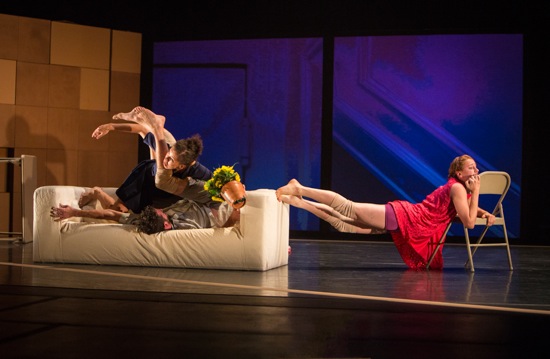
Andrea Miller’s Fold Here. Caroline Fermin and Dan Walczak on couch. Emily Terndrup at right. Photo: Yi-Chun Wu
In titling her wild new work Fold Here, Andrea Miller of Gallim Dance Company must have been thinking of all the implications of the instructions. Folding along prescribed creases makes a flat sheet of corrugated cardboard into a three-dimensional carton, and there are plenty of such boxes in Fold Here. Some form a tall wall; others can be carried onto the stage and used to build towers that can easily be knocked down or dismantled. A woman can be folded in an attempt to stuff her into a box. Putting a box over someone’s head erases, to a degree, that person’s identity. Boxes can come between friends.
Cardboard cartons, like relationships, are deceptively sturdy. It’s almost shocking how easy it is to tear them apart or drench them until they lose their shape. Folding can also mean giving up on a lost cause or conceding a fight. Think of Kenny Rogers’ advice to a novice gambler: “You got to know when to hold ’em, know when to fold ’em,/ Know when to walk away, know when to run.” Another line from the song is also pertinent: “knowin’ what to throw away and knowin’ what to keep.”
Miller’s program note is on a more intellectual plane. The last lines of Juan Rengito-Borrero’s short poem “Fold” declare: “Without hands and without feet/ you are a square./ With time you are a cube./ With feelings,/ It’s a box.” And, on a more visceral level, Miller, like any woman who has just carried a child for nine months, understands what it means to be a box, contents unknown.
Montclair State University’s Peak Performances is the principal commissioner of Fold Here, and the world premiere took place at the New Jersey institution’s Alexander Kasser Theatre. Local theater goers, students, and those who travel from New York City via train (weekdays only), special bus (weekends only), or car know that they can expect to see bold work, and Fold is something of a departure for Miller, in that it involves tons of “stuff,” courtesy of Miller’s collaborators: projection and video designer Tal Rosner; Jon Bausor, who’s credited with the set concept; lighting designer Robert Wierzel; costume designer Jenny Lai; and composer and sound designer, Andrzeij Przybytkowski.
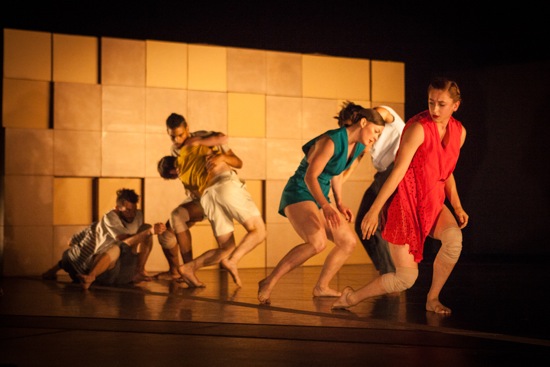
Against the “wall:” (L to R): Eric Berey (partly hidden), Dan Walczak, Matthew Perez, Austin Pendleton, Allysen Hooks, Daniel Staaf (partly hidden), Emily Terndrup. Photo: Yi-Chun Wu
Fold Here is also freighted with elusive meanings—or rather, meanings that are obvious, yet presented so strangely that we have to re-think what we perceive. As the piece begins, colored squares of light flash and re-pattern on the two panels facing us; later we will glimpse such familiar images as a brick wall, a black cat, a white house, as well as more abstract, often beautiful ones. The nine dancers—or some of them—first appear as silhouetted figures running back and forth across the stage as if searching for something. Then four banks of five lights each illuminate them where they huddle against a large wall of boxes set on a diagonal. There’s something stop-and-start about their dancing lives. They move vigorously, then freeze. At times, they are as jerky as robots or malleable dolls; they may have problems coordinating their limbs for the task at hand; their legs collapse under them.
Near the beginning of the piece, Matthew Perez—skinny and a head taller than anyone else onstage—gives an amazing display of folding, melting, caving in. His knees and ankles keep collapsing, pulling him to the floor. He seems fearful. He also, surprisingly, walks slowly, bent over like an old man. While he’s busy folding himself up, Allysen Hooks creeps onto the stage. She stands stiffly and blankly while he moves her; he gets her onto his back and crawls away with her. Meanwhile others bring boxes and build a new structure. A resting person’s legs stick out from a gap at the bottom.
Fold Here begins to seem like a series of “acts,” an absurdist vaudeville, when Francesca Romo (a co-founder of Gallim and its associate director) embarks on a dithery solo, kicking Perez out of her way. She twitches and staggers, romps and flirts, clearly aiming her performance at us. She also speaks, garbling her words and growling and squeaking them in ways that render her more or less unintelligible. She has trouble holding a box. The tension between her emotional and intellectual disarray and a recording of Glenn Gould’s crystalline playing of the theme of Bach’s Goldberg Variations is both unnerving and provocative.
The other performers are never out of sight for long. Romo tussles with Caroline Fermin over a box, and attempts other hopeless missions. If this were really a vaudeville, she would have been pulled offstage by “the hook” minutes ago. But choreographer Miller has another strategy. One set of boxes collapses, the dancers rush around like headless chickens, and the front curtain starts to descend. Suddenly Romo, this irritating, slightly disarming woman who’s been messing with us, gets beneath the curtain and stops it by holding it over her head with one hand. Finally it rises. Our heroine.
Now the subject becomes acquisitiveness and how boxed in we may be by our possessions and our roles and our relationships. The projections briefly show the layout of an apartment, and we get an initial overview of a room. That is, the white couch on which Emily Terndrup is attempting to lie is placed on end against the main “wall,” and other furnishings (a card table, folding chairs, a pot of flowers) are stacked there too. A scratchy recording of “Take All of Me” plays (actually we eventually hear two recordings: one by Louis Armstrong and His Orchestra, one by Billie Holiday).
As the performers arrange the furniture in a semblance of domesticity, they often get glued to the pieces or to each other. To one side, in what might be a wan comedy routine, Terndrup tries to pull her foot off the wall of boxes, only to get her hand stuck. Sitting on the couch, she and Dan Walczak hold their hands over their mouths and look as if they’re about to venture a kiss through these barricades. But no.
In one wonderfully desperate moment, Walzak (whose backless shirt may represent the hole in his life), buckles down and slowly pushes the couch, along with the chairs and table, toward one side of the stage. They’re not gotten rid of so easily. The others bring in duplicates and position them against the “wall.”
Occasionally these people dance (those not yet mentioned are Daniel Staaf, Austin Tyson and Eric Berey). That is, they gather on stage and go through big, gutsy moves—sometimes in unison, sometimes not, sometimes focusing in different directions. Were this truly a vaudeville, such a sequence would be simply an eye-filler; here it seems like an affirmation of normalcy amid the disoriented narratives. Fermin and Walczak seem to be a couple, Terndrup a child or “the other woman.” Fermin is fixated on having the plant set just so on the table with her sitting in front of it. Walczak picks up the chair with her in it. Terndrup would rather put a red-checked tablecloth over the table and anything else she can lay her hands on and hide underneath. Walczak crams Terndrup into a box, shoves it, and tips it. They put a box over their heads. Terndrup rips another up. Walczak wanders with a destroyed one.
The problem becomes one of knowing when to let go (of a possession, of a relationship). People start moving things around, taking boxes to build new structures: walls, caves, holes to crawl into. Fermin wants to hang on to all that she can, and she holds fast to things, until they are pulled away from her. Whole stacks of boxes are pushes away; openings appear in others. The score provides crashes and pandemonium. Suddenly everyone is running. Suddenly everyone is dancing.
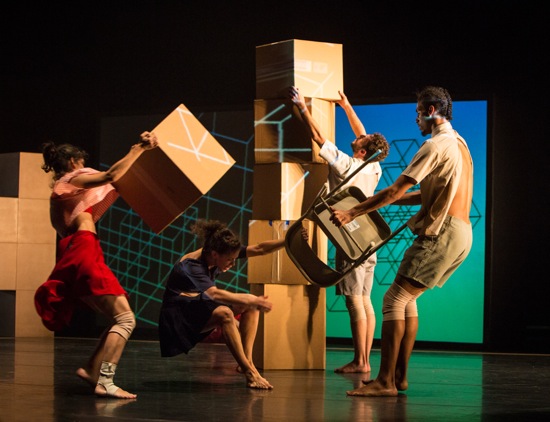
Building and holding onto. (L to R): Francesca Romo, Caroline Fermin, Dan Walczak, and Matthew Perez in Andrea Miller’s Fold Here. Photo: Yi-Chun Wu
A microphone appears, and people briefly, curiously, identify themselves or others. Meanwhile Tyson is dancing marvelously—now with stops and starts, now all fluid confusion. But this “act” is somehow restorative. He smiles—happy, unsnarled. The dancers take turns walking toward us like runway models, pausing to show off a chest, an armpit. Here comes “Take All of Me” again. Berey displays his high kicks. Romo puts boxes over the heads of Staats and Fermin. They embrace. The curtain comes down.
The effect of Fold Here is unsettling. I feel I’ve been entertained, disturbed, confused, made to think. The performers are marvels, their characters’ behavior and their stifled desires both comical and profoundly sad. In rendering a society’s topsy-turvy inner worlds and misdirected yearnings in visual, physical, and colorful terms, Miller has created an adult playground that, no matter how much you re-arrange its equipment, fences you in.

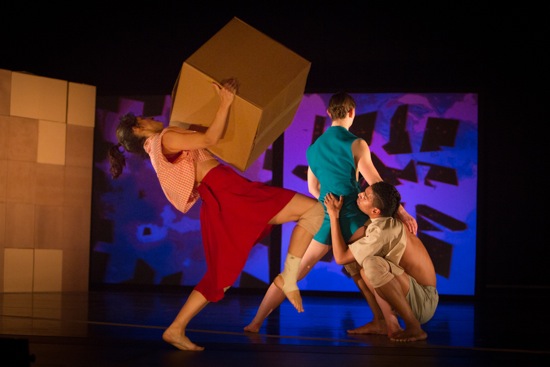
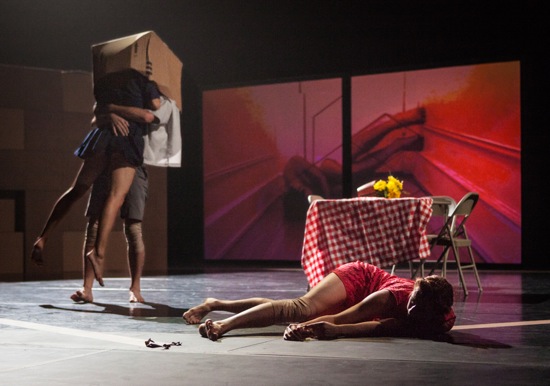
I believe the song’s title is simply “All of Me.”